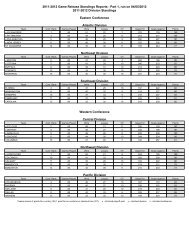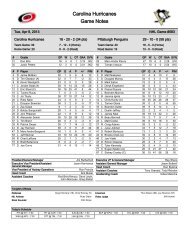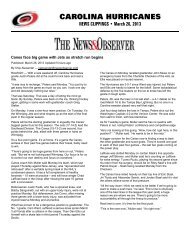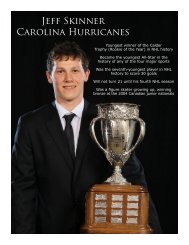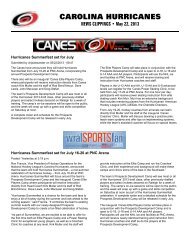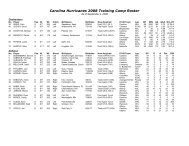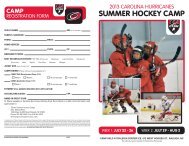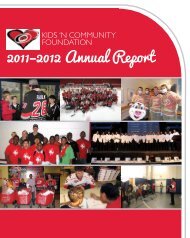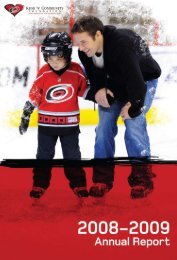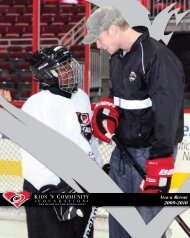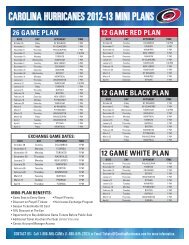2011-12 MEDIA GUIDE - Carolina Hurricanes - NHL.com
2011-12 MEDIA GUIDE - Carolina Hurricanes - NHL.com
2011-12 MEDIA GUIDE - Carolina Hurricanes - NHL.com
You also want an ePaper? Increase the reach of your titles
YUMPU automatically turns print PDFs into web optimized ePapers that Google loves.
Labrum (Labrum glenoidule): The cartilage of the glenoid cavity in the shoulder.<br />
a lip edged or lip like structure.<br />
Lateral Collateral Ligament (LCL): Ligament of the knee along the outer aspect<br />
that connects the femur to the fibula. it provides lateral stability to the joint.<br />
Ligament: Band of fibrous tissue that connects bone to bone or bone to cartilage<br />
and supports and strengthens joints.<br />
Magnetic Resonance Imaging (MRI): imaging procedure in which a radio<br />
frequency pulse causes certain electrical elements of the injured tissue to react to<br />
this pulse and through this process a <strong>com</strong>puter display and permanent film establish<br />
a visual image. MRi does not require radiation and is very useful in the diagnosis of<br />
soft tissue, disc and meniscus injuries.<br />
Mandible: Jaw bone.<br />
Medial Collateral Ligament (MCL): Ligament of knee along the inner aspect that<br />
connects the femur to the tibia.<br />
Meniscus: Crescent-shaped cartilage, usually pertaining to the knee joint; also<br />
known as cartilage. There are two menisci in the knee: medial and lateral. These<br />
work to absorb weight within the knee and provide stability.<br />
Metacarpals: Five long bones of the hand, joining the fingers to the wrist.<br />
Metatarsals: Five long bones of the foot, running from the ankle to the toes.<br />
Myositis: inflammation of a muscle.<br />
Open Reduction: Re-alignment of a fracture or dislocation with surgery.<br />
Orthotic: any device applied to or around the body of physical impairment of<br />
disability. Commonly used to control foot mechanics.<br />
Osteochondritis Dessicans: a piece of bone and/or cartilage loosened from its<br />
attachment after trauma and a cause of a lesion.<br />
Osteomyelitis: an inflammatory disease of bone caused usually by infection with<br />
streptococcus or staphylococcus bacteria.<br />
Patella: The kneecap. The patella functions to protect the distal end of the femur<br />
as well as increase the mechanical advantage and force generating capacities of<br />
the quadriceps muscle group.<br />
Plantar fasciitis: inflammation of the plantar (a thick tissue on the bottom of<br />
the foot which helps create the arch) fascia; associated with overuse or acute<br />
foot injury.<br />
Posterior Cruciate Ligament (PCL): a primary stabilizing ligament of the knee<br />
that provides significant stability and prevents displacement of the tibia backward<br />
within the knee joint. a <strong>com</strong>plete tear of this ligament necessitating reconstruction<br />
could require up to <strong>12</strong> months of rehabilitation.<br />
Quadricep Muscles: a group of four muscles of the front thigh that run from<br />
the hip and form a <strong>com</strong>mon tendon at the patella; they are responsible for<br />
knee extension.<br />
Radius: Bone in the forearm from elbow to the thumb side of the wrist.<br />
Reconstruction: Surgical rebuilding of a joint using natural, artificial or<br />
transplanted materials.<br />
Rotator Cuff: Comprised of four muscles in the shoulder area that can be irritated by<br />
overuse. The muscles are the supraspinatus (most <strong>com</strong>monly injured), infraspinatus,<br />
teres minor and subscapularis.<br />
Sacroiliac: Junction of the sacrum, the lower back bone, with the pelvis.<br />
Sacrum: Group of five fused vertebrae located just below the lumbar vertebrae of<br />
the lower back, which form part of the pelvis.<br />
Scapula: Shoulder blade.<br />
Sciatica: irritation of the sciatic nerve resulting in pain or tingling running down<br />
the inside of the leg.<br />
Sciatic Nerve: Major nerve that carries impulses for muscular action and sensations<br />
between the low back and thigh and lower leg; it is the longest nerve in the body.<br />
Shin Splint: a catch all syndrome describing pain in the shin that is not a fracture<br />
or tumor and cannot be defined otherwise.<br />
Spleen: Large, solid organ responsible for the normal production and destruction of<br />
blood cells located under the left rib cage.<br />
Spondylosis: abnormal vertebral fixation or immobility, or a general term for<br />
arthritis of the spine.<br />
Sprain: injury resulting from the stretching or twisting of the joint and causes<br />
various degrees of stretching or tearing of a ligament or other soft tissue at<br />
the joint.<br />
MEDICAL GLOSSARY<br />
Strain: injury resulting from a pulling or torsion to the muscle or tendon that causes<br />
various degrees of stretching or tearing to the muscle or tendon tissue.<br />
Stress fracture: a hair line type of break in a bone. Caused by overuse.<br />
Subluxation: Partial dislocation of a joint. The term usually implies that the joint<br />
can return to a normal position without formal reduction.<br />
Synovial fluid: Lubricating fluid for joints and tendons, produced in synovium, or<br />
the inner lining of a joint.<br />
Synovitis: inflammation of the synovial lining of a joint.<br />
Talus: The ankle bone that articulates with the tibia and fibula to form the<br />
ankle joint.<br />
Tarsals: Group of seven bones of the foot consisting of the calnavicular, talus,<br />
cuboid and three cuneiform bones.<br />
Tendinitis: inflammation of the tendon and/or tendon sheath, caused by chronic<br />
overuse or sudden injury.<br />
Tendon: Tissue that connects muscle to bone.<br />
Tenosynovitis: Swelling or inflammation of a tendon sheath caused by calcium<br />
deposits, repeated strain or trauma.<br />
Tibia: Shin bone; larger of the two bones of the lower leg and is the weight bearing<br />
bone of the shin.<br />
Transcutaneous Electrical Nerve Stimulator (TENS): an electrical modality<br />
that sends a mild current through pads at the injury site which stimulates the brain<br />
to release the natural analgesic endorphin.<br />
Transverse Process: Small lateral projection off the right and left side of each<br />
vertebrae that functions as an attachment site for muscles and ligaments of<br />
the spine.<br />
Triceps: Muscle of the back of the upper arm, primarily responsible for extending<br />
the elbow.<br />
ulna: inner bone of the forearm that runs from the tip of the elbow to the little finger<br />
side of the wrist.<br />
ulnar Nerve: Nerve in the elbow <strong>com</strong>monly irritated from excessive throwing.<br />
ultrasound: an electrical modality that transmits a sound wave through an<br />
applicator into the skin to the soft tissue in order to heat the local area for relaxing<br />
the injured tissue and/or disperse edema… also a type of imaging study for certain<br />
body areas.<br />
“wind knocked Out”: Syndrome describing a contraction of the abdominal nerve<br />
truck, the solar plexus, as a result of an abdominal contusion.<br />
<strong>2011</strong>-<strong>12</strong> Media Guide / 263




